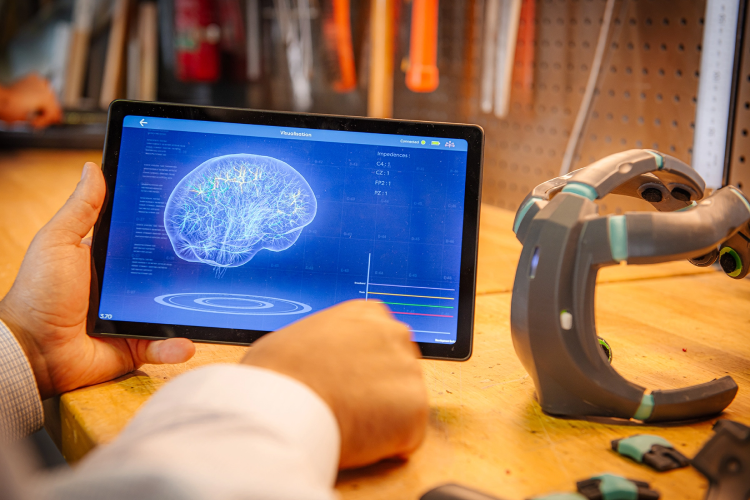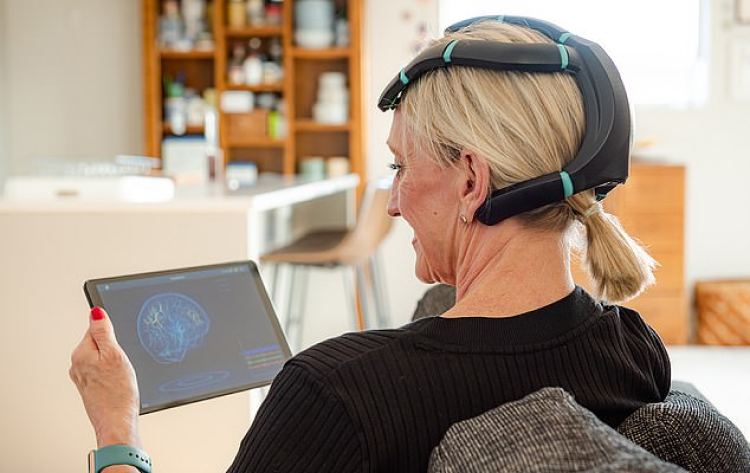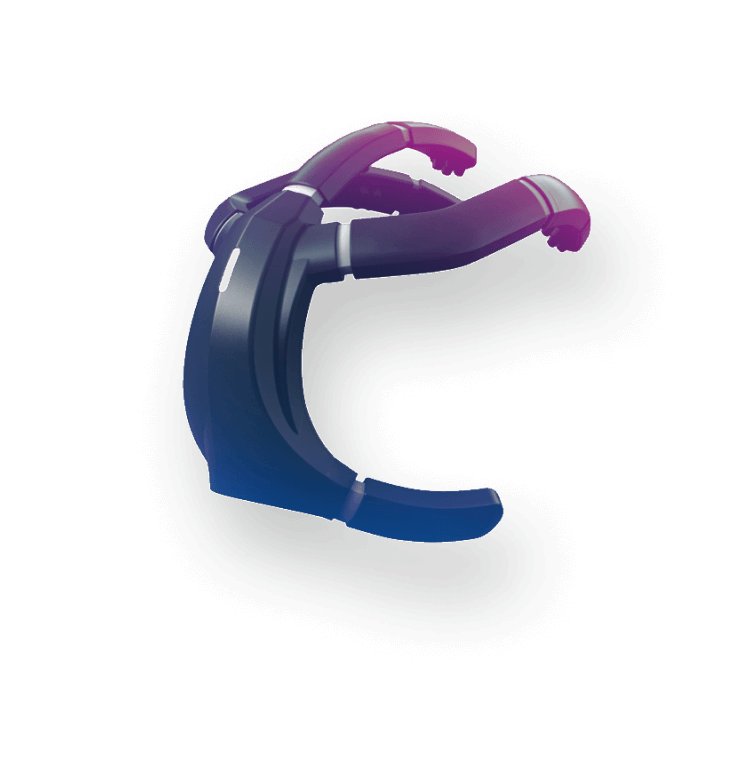About EEG
Table of contents
- 01. How has Exsurgo transformed EEG technology?
- 02. What Is an EEG?
- 03. What Information Comes From an EEG
- 04. EEG Neurofeedback
- 05. Does an EEG Have Risks or Side Effects
- 06. What makes Axon different?
00.
Intro
It is remarkable how such a complex, highly sophisticated organ like the brain can be mapped with the use of an electroencephalogram (EEG).
An EEG is a test that measures the electrical activity in your brain by measuring impulses using electrodes placed on the scalp.
Despite its non-invasive, convenient nature, an EEG is one of the most widespread tests used to diagnose and treat a range of conditions. An EEG can find changes in brain activity that might be useful in diagnosing brain disorders, especially epilepsy or another seizure disorder. An EEG might also be helpful for diagnosing or treating:
- Brain tumours
- Brain damage from head injury
- Brain dysfunction that can have a variety of causes (encephalopathy)
- Sleep disorders
- Inflammation of the brain (herpes encephalitis)
- Stroke
- Sleep disorders
- Creutzfeldt-Jakob disease
An EEG machine consists of a number of electrodes which connect to a computer or recording machine for interpretation.
In simple terms, an electroencephalogram records “brain waves” and prints out the data obtained as a series of brain wave patterns. Experienced healthcare providers compare the EEG data with certain baselines to identify normal and abnormal conditions.
01.
How has Exsurgo transformed EEG technology?
Traditionally, using an EEG machine to monitor brain activity requires attendance at a specialist clinic, with an expert clinician on hand to interpret data. The equipment can also cost up to hundreds of thousands of dollars.
Exsurgo’s Axon technology transforms the EEG process through a miniaturised headset, Cloud-based AI for analytics, and a consumer-friendly app. While existing EEG science underpins Axon, Exsurgo has transformed EEG Neurofeedback into a cost-effective, mobile system that can be used in a professional clinical setting or at a patient’s home.
As well as using EEG Neurofeedback for the management of chronic pain, Exsurgo is looking to develop its Axon solution as an effective diagnostic tool and as a treatment for a wide range of other neurologically related conditions.
At a fraction of the price of traditional EEG technology, Axon empowers everyone, everywhere to manage their own treatment from the comfort of their own home.

02.
What is an EEG?
Whilst Exsurgo and Axon is changing the way EEGs will be carried out in the future, traditional EEG monitoring is still widely used throughout the world.
As the name suggests, electroencephalography is a method by which the electrical activity of the brain is detected and recorded. The name is derived from the words electro (electricity), encephalon (brain) and graph (to write or record).
An electroencephalogram (EEG) is the recording made of the brain’s electrical activity. This is achieved by pasting metal discs (called electrodes) around the scalp and using highly sensitive equipment to detect and record the signals received.
The test results of an EEG will be reviewed by a medical expert such as a neurosurgeon, for reading and interpretation.
03.
Types of EEG
There are several types of EEGs based on how the procedure is conducted and the expected results.
Brain activity changes significantly between sleep and wakefulness, moments of rest and moments of activity, among others. External stimuli such as strobe lights or sounds can also affect brain waves.
- Routine EEG—This is a standard test that will take anywhere from half an hour to two hours. The patient is awake but will need to follow instructions as they are requested.
- Video EEG—Routine EEGs may also be performed together with a video recording of the session. This allows neurosurgeons interpreting the results to have more information than just the printouts of the recording.
- Ambulatory EEG—This is a test where brain activity is recorded over a period of one or more days. This is accomplished by using a portable EEG recorder, allowing you to proceed with your usual activities.
- Ambulatory Video EEG—This is a prolonged EEG, usually 24 hours or more, that is performed either at the patient’s home or in a hospital. This is rarely used unless a brain condition such as epilepsy is being detected.
03.
What Information Comes From an EEG
The electrical patterns recorded during an EEG reflect the electrical activity in the cerebral cortex, which is the outer layer immediately next to the skull. The electrical waveforms and their frequencies are measured and amplified to allow brain experts or computer algorithms to analyse them. Brain cells communicate via electrical impulses and are active all the time, even during sleep. This activity shows up as wavy lines on an EEG recording.
In particular, there are four types of brain waves that an EEG reveals:

Alpha Waves
Alpha brain waves have a frequency of 8-12Hz and are most commonly found in relaxed adults. In this state, the person is feeling at ease and calm and they can accomplish what they are doing easily, quickly, and efficiently.
Alpha waves are comparable to a neutral gear in a car because they allow the brain to shift easily from one state to another. They appear when a person is alert, attentive, and thinking actively.

Beta Waves
When a person switches to active tasks or is stimulated, Beta waves with a frequency of 13—40Hz appear on an EEG. They are associated with wakefulness (open eyes), analytical thinking, judgement, decision-making, among other intensive tasks.
There are different levels of Beta waves that are usually subdivided into Low Beta, Mid-Beta, and High Beta (also known as Gamma waves. All these reflect on the intensity of the task at hand.

Delta Waves
These are brain waveforms with a frequency of 3 Hz or less. On an EEG, they show up as the highest waves (maximum amplitude) and are the slowest. They often occur during deep sleep and are also common in infants.
However, when Delta waves show up in adults during wakeful stages, it could indicate disorders such as ADD. That’s because Delta waves are like the brain’s first gear and should only show up when at complete rest.

Theta Waves
These are brain waves with a frequency of 3.6-7.5Hz (cycles per second). They are associated with “slow” brain activity and are connected with memories, intuition, daydreaming, meditation, prayer, and other restful moments.
Theta waves are the link between wakefulness and sleep and are very useful in deep behaviors such as learning and memory. For that reason, they are very common in young children up to 13 years of age, but abnormal in awake, active adults.
04.
EEG Neurofeedback
With the help of modern technology such as Machine Learning (ML), a system of feedback to help the brain self-regulate can be set up.
Since the brain loves and relies on “reward” mechanisms for training, a positive feedback loop can be created to encourage learning, memory, or other positive attributes. A negative feedback loop can also be used to discourage addictions, bad habits, or in this case, sensitivity to pain.
Axon works in a very similar way. When wearing the Axon headset, brain activity data is tracked and displayed on the user’s own mobile device via our app. Through real-time visual feedback, the user learns to neuro-modulate the pain signals by recognising and modifying their response, causing a significant decrease in pain, all done from the comfort of their own home.

07.
What Does EEG Mean? Normal vs Abnormal Brain Function
Patterns in these four types of brain waves allow neurosurgeons to compare the height, shape, location, and frequency of brain waves with what is considered “normal” function. For example, Delta waves are not normal in adults who are awake and could indicate a problem.
Sudden interruptions in the wave activity of the brain in the absence of external stimuli could also indicate “abnormal” function. This can happen during a seizure or, in this case, a bout of pain.
Computerised qEEG analysis uses a large dataset of EEG results to compare your brain data to a large database of conventionally functioning brains. This method also shows deviations that could, for example, show what region of the brain is responsible for your chronic pain.
05.
Why carry out an EEG?
In most cases, an EEG is used as a tool to diagnose brain disorders or injury. It is a very useful tool in diagnosing conditions including epilepsy, brain tumors, encephalitis (inflammation of the brain), stroke, sleep disorders, and brain dysfunction (such as encephalopathy).
When you’re not looking for anomalies in brain activity, an EEG can be a valuable tool in many areas of treatment, now known as “neurotherapy.” It involves using some form of stimulation to affect brain waves, as described above.
Neurotherapy techniques have been in use for some time now. Current research shows that neurotherapy can be useful in helping to improve the symptoms of PTSD, bipolar disorder, ADHD, anxiety, and more.
Some extreme athletes have also been using neurotherapy to improve attention and focus, slow cognitive decline, improve emotional control, and other areas of athleticism.
At Exsurgo, we extended the use of qEEG and biofeedback for reducing chronic pain. While this is a relatively new field of study with limited clinical trials, we have seen some significant success in targeting brain regions that cause pain.
Such brain regions will show up as “abnormal” in an qEEG, where machine learning and a mix of visual and auditory feedback can be used to help modulate brain waves in that region.
08.
How Long Does an EEG Take and What Does it Involve?
The procedure of an EEG is non-intrusive, painless, and even relaxing. During the actual test, trained personnel (technicians) will place an electrode cap on your head.
The electrode cap contains 16-25 electrodes, which are flat metal discs that pick up the electrical activity of the brian. A routine EEG should take 20-40 minutes, but preparation time could push this to 2 hours.
In this case preparation might involve:
- Washing your hair and drying it to get rid of hair products, oil in the scalp, and anything else that might affect electrode readings
- Applying a conductive gel to help improve the electrical signal from the brain
- The technician might also use a wax crayon to map out specific areas where the electrodes should go and fix individual electrodes to the scalp using washable glue
During the test itself, the technician will have you relax in a reclining chair in a dark and quiet room. This eliminates external stimuli which could register “noise” on the EEG test.
You might also be asked to blink, look at flashing lights, or breathe deeply to help associate certain brain waves with these voluntary acts. However, most of an EEG occurs when you are relaxed, with your eyes closed, and perfectly still but not asleep.
05.
Does an EEG Have Risks or Side Effects?
An EEG is a perfectly safe test with no side effects. Since no drugs or intrusive procedures are involved, most people should experience no discomfort or health issues related to an EEG test.
10.
Getting Ready for an EEG
- Wash your hair with shampoo, but do not use any hair conditioner or other hair care products
- Tell the technicians about any medication you are taking, including over-the-counter drugs
- Don’t use any stimulating food or drinks such as coffee 12 hours before the test
- Follow any directions about reducing sleep before the test. Some EEG tests require sleep deprivation for accurate diagnosis
- Don’t fast the night before. Eating healthy helps increase the accuracy of the test
06.
What makes Axon different?
A UK clinical trial saw participants who suffered from various types of chronic pain using Axon from the comfort of their own home to measure changes in pain intensity alongside associated symptoms (depression, anxiety, sleep, and quality of life).
The trial was led by Dr Nick Birch, an Orthopaedic Consultant, and his analysis suggests the deployment of Axon has the potential to save the UK healthcare economy in the region of £5.6B (US$7.9B) per year.
In the US, he says the potential impact of Axon is three times as great as in the UK in terms of cost-effectiveness, but will also have a major impact on reducing opiate dependence and the annual death toll from opiate overdoses.
As well as the potential cost-savings that Axon could bring to healthcare systems, there is also the impact on patients.
Axon can be used from the comfort of your own home and the “treatment” takes approximately 30 minutes per session. There is no need for specific preparation – no washing your hair, applying conductive gel or mapping where the electrodes are going to be placed.
This helps to reduce anxiety in patients as well as saving them (and caregivers) precious time, with no commuting to a healthcare clinic or hospital required.
Find out more about Axon below or get in touch with the team today to learn more about Axon or our latest trials.
